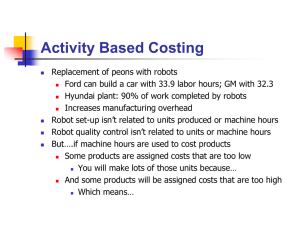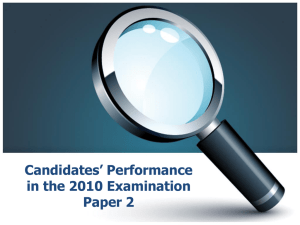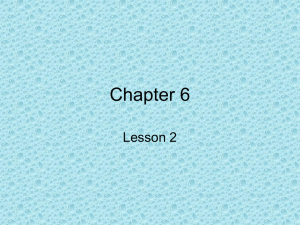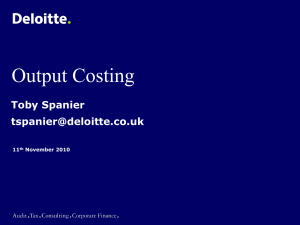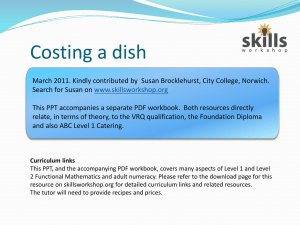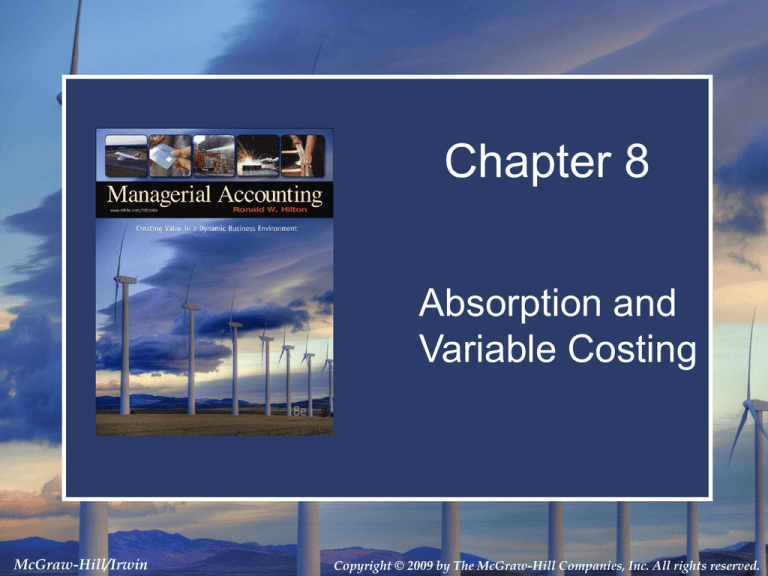
Chapter 8
Absorption and
Variable Costing
McGraw-Hill/Irwin
Copyright © 2009 by The McGraw-Hill Companies, Inc. All rights reserved.
Learning
Objective
1
McGraw-Hill/Irwin
Copyright © 2009 by The McGraw-Hill Companies, Inc. All rights reserved.
Absorption Costing
A system of accounting for costs in which
both fixed and variable production costs
are considered product costs.
Fixed
Costs
Product
Variable
Costs
8-3
Variable Costing
A system of cost accounting that only
assigns the variable cost of production to
products.
Fixed
Costs
Product
Variable
Costs
8-4
Absorption and Variable Costing
A b so rp tio n
V a ria b le
C o stin g
C o stin g
D ire ct m a te ria ls
D ire ct la b o r
P ro d u ct co sts
P ro d u ct co sts
V a ria b le m fg . o ve rh e a d
F ix e d m fg . o ve rh e a d
P e rio d co sts
P e rio d co sts
S e llin g & A d m in . e x p .
8-5
Absorption and Variable Costing
A b so rp tio n
V a ria b le
C o stin g
C o stin g
D ire ct m a te ria ls
D ire ct la b o r
P ro d u ct co sts
P ro d u ct co sts
V a ria b le m fg . o ve rh e a d
F ix e d m fg . o ve rh e a d
P e rio d co sts
P e rio d co sts
S e llin g & A d m in . e x p .
The difference between absorption and variable
costing is the treatment of fixed manufacturing overhead.
8-6
Learning
Objective
2
McGraw-Hill/Irwin
Copyright © 2009 by The McGraw-Hill Companies, Inc. All rights reserved.
Absorption and Variable Costing
Let’s put some numbers to an example and
see what we can learn about the difference
between absorption and variable costing.
8-8
Absorption and Variable Costing
Mellon Co. produces a single product with
the following information available:
25,000
N u m b e r o f u n its p ro d u ce d a n n u a lly
V a ria b le co sts p e r u n it:
D ire ct m a te ria ls, d ire ct la b o r
a n d va ria b le m fg . o ve rh e a d
$
10
$
3
S e llin g & a d m in istra tive
e x p e n se s
F ix e d co sts p e r ye a r:
M fg . o ve rh e a d
$ 150,000
S e llin g & a d m in istra tive
e x p e n se s
$ 100,000
8-9
Absorption and Variable Costing
Unit product cost is determined as follows:
A b so rp tio n
V a ria b le
C o stin g
C o stin g
D ire ct m a te ria ls, d ire ct la b o r, a n d
va ria b le m fg . o ve rh e a d
$
10
$
10
F ix e d m fg . o ve rh e a d
($150,000 ÷ 25,000 u n its)
U n it p ro d u ct co st
6
$
16
$
10
Selling and administrative expenses are
always treated as period expenses and
deducted from revenue.
8-10
Absorption Costing
Income Statements
Mellon Co. had no beginning inventory, produced
25,000 units and sold 20,000 units this year at $30
each. Ab so rp tio n C o stin g
S a le s (20,000 × $30 )
$ 600,000
L e ss co st o f g o o d s so ld :
B e g in n in g in ve n to ry
Add CO G M
G o o d s a va ila b le fo r sa le
En d in g in ve n to ry
G ro ss m a rg in
L e ss se llin g & a d m in . e x p .
V a ria b le
F ix e d
N e t in co m e
8-11
Absorption Costing
Income Statements
Mellon Co. had no beginning inventory, produced
25,000 units and sold 20,000 units this year at $30
each. Ab so rp tio n C o stin g
S a le s (20,000 × $30)
$ 600,000
L e ss co st o f g o o d s so ld :
B e g in n in g in ve n to ry
A d d C O G M (25,000 × $16)
G o o d s a va ila b le fo r sa le
En d in g in ve n to ry (5,000 × $16)
G ro ss m a rg in
$
400,000
$ 400,000
80,000
320,000
$ 280,000
L e ss se llin g & a d m in . e x p .
V a ria b le
F ix e d
N e t in co m e
8-12
Absorption Costing
Income Statements
Mellon Co. had no beginning inventory, produced
25,000 units and sold 20,000 units this year at $30
each.
Ab so rp tio n C o stin g
S a le s (20,000 × $30)
$ 600,000
L e ss co st o f g o o d s so ld :
B e g in n in g in ve n to ry
$
A d d C O G M (25,000 × $16)
G o o d s a va ila b le fo r sa le
400,000
$ 400,000
En d in g in ve n to ry (5,000 × $16)
80,000
G ro ss m a rg in
320,000
$ 280,000
L e ss se llin g & a d m in . e x p .
V a ria b le (20,000 × $3)
F ix e d
N e t in co m e
$
60,000
100,000
160,000
$ 120,000
8-13
Learning
Objective
3
McGraw-Hill/Irwin
Copyright © 2009 by The McGraw-Hill Companies, Inc. All rights reserved.
Variable Costing
Income Statements
Now let’s look at variable costing by Mellon
Co.
Variab le C o stin g
S a le s (20,000 × $30)
$
600,000
L e ss va ria b le e x p e n se s:
B e g in n in g in ve n to ry
$
-
Add CO G M
G o o d s a va ila b le fo r sa le
En d in g in ve n to ry
V a ria b le co st o f g o o d s so ld
V a ria b le se llin g & a d m in istra tive
e x p e n se s
C o n trib u tio n m a rg in
L e ss fix e d e x p e n se s:
M a n u fa ctu rin g o ve rh e a d
S e llin g & a d m in istra tive e x p e n se s
N e t in co m e
8-15
Variable Costing
Income Statements
Now let’s look at variable costing by Mellon
Co. We exclude the
S a le s (20,000 × $30)
L e ss va ria b le e x p e n se s:
B e g in n in g in ve n to ry
A d d C O G M (25,000 × $10)
G o o d s a va ila b le fo r sa le
En d in g in ve n to ry (5,000 × $10)
V a ria b le co st o f g o o d s so ld
Variab
le C o stin g
fixed
manufacturing
$ 600,000
overhead.
$
250,000
$ 250,000
50,000
$ 200,000
V a ria b le se llin g & a d m in istra tive
e x p e n se s
C o n trib u tio n m a rg in
L e ss fix e d e x p e n se s:
M a n u fa ctu rin g o ve rh e a d
S e llin g & a d m in istra tive e x p e n se s
N e t in co m e
8-16
Variable Costing
Income Statements
Now let’s look at variable costing by Mellon
Co.
Variab le C o stin g
S a le s (20,000 × $30)
$
600,000
L e ss va ria b le e x p e n se s:
B e g in n in g in ve n to ry
A d d C O G M (25,000 × $10)
G o o d s a va ila b le fo r sa le
En d in g in ve n to ry (5,000 × $10)
V a ria b le co st o f g o o d s so ld
$
250,000
$ 250,000
50,000
$ 200,000
V a ria b le se llin g & a d m in istra tive
e x p e n se s (20,000 × $3)
60,000
C o n trib u tio n m a rg in
260,000
$
340,000
L e ss fix e d e x p e n se s:
M a n u fa ctu rin g o ve rh e a d
S e llin g & a d m in istra tive e x p e n se s
N e t in co m e
$ 150,000
100,000
250,000
$
90,000
8-17
Comparing Absorption and
Variable Costing
Let’s compare the methods.
C o st o f
Goods
En d in g
P e rio d
S o ld
In ve n to ry
Ex p e n se
T o ta l
A b so rp tio n co stin g
V a ria b le m fg . co sts
F ix e d m fg . co sts
$ 200,000
120,000
$ 320,000
V a ria b le co stin g
V a ria b le m fg . co sts
F ix e d m fg . co sts
$ 200,000
$ 200,000
8-18
Comparing Absorption and
Variable Costing
Let’s compare the methods.
Cost of
Goods
Sold
Ending
Inventory
Period
Expense
Absorption costing
Variable mfg. costs $ 200,000
Fixed mfg. costs
120,000
$ 320,000
$ 50,000
30,000
$ 80,000
$
Variable costing
Variable mfg. costs $ 200,000
Fixed mfg. costs
$ 200,000
$ 50,000
$ 50,000
$
$
Total
-
150,000
$ 150,000
8-19
Comparing Absorption and
Variable Costing
Let’s compare the methods.
Cost of
Goods
Sold
Ending
Inventory
Period
Expense
Absorption costing
Variable mfg. costs $ 200,000
Fixed mfg. costs
120,000
$ 320,000
$ 50,000
30,000
$ 80,000
$
Variable costing
Variable mfg. costs $ 200,000
Fixed mfg. costs
$ 200,000
$ 50,000
$ 50,000
$
$
-
150,000
$ 150,000
Total
$ 250,000
150,000
$ 400,000
$ 250,000
150,000
$ 400,000
8-20
Learning
Objective
4
McGraw-Hill/Irwin
Copyright © 2009 by The McGraw-Hill Companies, Inc. All rights reserved.
Reconciling Income Under
Absorption and Variable Costing
We can reconcile the difference between
absorption and variable net income as
follows:
V a ria b le co stin g n e t in co m e
$
90,000
A d d : F ix e d m fg . o ve rh e a d co sts
d e fe rre d in in ve n to ry
(5,000 u n its × $6 p e r u n it)
A b so rp tio n co stin g n e t in co m e
Fixed mfg. overhead
$150,000
=
Units produced
25,000
30,000
$
120,000
= $6.00 per unit
8-22
Learning
Objective
5
McGraw-Hill/Irwin
Copyright © 2009 by The McGraw-Hill Companies, Inc. All rights reserved.
Cost-Volume-Profit Analysis
• CVP includes all fixed costs to compute
breakeven.
– Variable costing and CVP are consistent as both
treat fixed costs as a lump sum.
• Absorption costing defers fixed costs into
inventory.
– Absorption costing is inconsistent with CVP
because absorption costing treats fixed costs on
a per unit basis.
8-24
Learning
Objective
6
McGraw-Hill/Irwin
Copyright © 2009 by The McGraw-Hill Companies, Inc. All rights reserved.
Extending the Example
Let’s look at
the second
year of
operations
for Mellon
Company.
8-26
Mellon Co. Year 2
In its second year of operations, Mellon Co. started with
an inventory of 5,000 units, produced 25,000 units and
sold 30,000 units at $30 each.
N u m b e r o f u n its p ro d u ce d a n n u a lly
25,000
V a ria b le co sts p e r u n it:
D ire ct m a te ria ls, d ire ct la b o r
a n d va ria b le m fg . o ve rh e a d
$
10
$
3
S e llin g & a d m in istra tive
e x p e n se s
F ix e d co sts p e r ye a r:
M fg . o ve rh e a d
$ 150,000
S e llin g & a d m in istra tive
e x p e n se s
$ 100,000
8-27
Mellon Co. Year 2
Unit product cost is determined as
follows:
A b so rp tio n
V a ria b le
C o stin g
C o stin g
D ire ct m a te ria ls, d ire ct la b o r,
a n d va ria b le m fg . o ve rh e a d
$
10
$
10
F ix e d m fg . o ve rh e a d
($150,000 ÷ 25,000 u n its)
U n it p ro d u ct co st
6
$
16
$
10
There has been no
change in Mellon’s
cost structure.
8-28
Mellon Co. Year 2
Now let’s look at Mellon’s income statement
assuming absorption costing is used.
8-29
Mellon Co. Year 2
Units in ending inventory from the previous period.
Ab so rp tio n C o stin g
S a le s (30,000 × $30)
$ 900,000
L e ss co st o f g o o d s so ld :
B e g . in ve n to ry (5,000 x $16)
$
A d d C O G M (25,000 × $16)
G o o d s a va ila b le fo r sa le
80,000
400,000
$ 480,000
En d in g in ve n to ry
-
G ro ss m a rg in
480,000
$ 420,000
L e ss se llin g & a d m in . e x p .
V a ria b le (30,000 × $3)
F ix e d
N e t in co m e
$
90,000
100,000
190,000
$ 230,000
8-30
Mellon Co. Year 2
Ab so rp tio n C o stin g
S a le s (30,000 × $30)
$ 900,000
L e ss co st o f g o o d s so ld :
B e g . in ve n to ry (5,000 x $16)
$
A d d C O G M (25,000 × $16)
G o o d s a va ila b le fo r sa le
80,000
400,000
$ 480,000
En d in g in ve n to ry
-
G ro ss m a rg in
480,000
$ 420,000
L e ss se llin g & a d m in . e x p .
V a ria b le (30,000 × $3)
F ix e d
N e t in co m e
$
90,000
100,000
190,000
$ 230,000
25,000 units produced in the current period.
8-31
Mellon Co. Year 2
Next, we’ll look at Mellon’s income statement
assuming variable costing is used.
8-32
Mellon Co. Year 2
Variab le C o stin g
S a le s (30,000 × $30)
$
900,000
L e ss va ria b le e x p e n se s:
B e g . in ve n to ry (5,000 × $10)
$
A d d C O G M (25,000 × $10)
G o o d s a va ila b le fo r sa le
250,000
$
En d in g in ve n to ry
V a ria b le co st o f g o o d s so ld
50,000
300,000
-
$
300,000
V a ria b le se llin g & a d m in istra tive
e x p e n se s (30,000 × $3)
90,000
C o n trib u tio n m a rg in
390,000
$
510,000
L e ss fix e d e x p e n se s:
M a n u fa ctu rin g o ve rh e a d
S e llin g & a d m in istra tive e x p e n se s
N e t in co m e
$
150,000
100,000
250,000
$
260,000
Excludes fixed manufacturing overhead.
8-33
Summary
In c o m e C o m p a ris o n
C o stin g M e th o d
A b so rp tio n
V a ria b le
1st P e rio d
$ 120,000
90,000
2n d P e rio d
$
T o ta l
230,000
$ 350,000
260,000
350,000
In the first period, production (25,000 units)
was greater than sales (20,000).
In the second period, production (25,000 units)
was less than sales (30,000).
8-34
Summary
In c o m e C o m p a ris o n
C o stin g M e th o d
A b so rp tio n
V a ria b le
1st P e rio d
$ 120,000
90,000
2n d P e rio d
$
T o ta l
230,000
$ 350,000
260,000
350,000
For the two-year period, total absorption
income and total variable income are the same.
8-35
Summary
Let’s see if we can get an overview
of what we have done.
8-36
Summary Comparison of
Absorption (AC) and Variable
Costing (VC)
T o ta l
P ro d u ctio n ve rsu s
In ve n to ry
S a le s
Effe ct
P e rio d Ex p e n se Effe ct
F ix e d m fg .
P ro d u ce d > S o ld
In cre a se
co sts e x p e n se d
AC
P ro fit Effe ct
F ix e d m fg .
< co sts e x p e n se d
AC > V C
VC
e d m fgperiod
.
Fwhen
ix e d m fgproduction
.
This was the case in theF ixfirst
P ro d u ce d < S o ld
D e cre a se
co sts e x p e n se d > co sts e x p e n se d
AC < V C
of 25,000 units was greaterA Cthan sales of
20,000
units.
VC
F ix e d mzero
fg .
F ix e d munits
fg .
Inventory increased from
to 5,000
and
P ro d u ce d = S o ld
N o ch a n g e
co sts e x p e n se d = co sts e x p e n se d
AC =
$120,000 absorption income
was greater
than
AC
VC
$90,000 variable income.
VC
8-37
Summary Comparison of
Absorption (AC) and Variable
Costing (VC)
T o ta l
P ro d u ctio n ve rsu s
In ve n to ry
S a le s
Effe ct
P e rio d Ex p e n se Effe ct
F ix e d m fg .
P ro d u ce d > S o ld
P ro d u ce d < S o ld
In cre a se
D e cre a se
co sts e x p e n se d
F ix e d m fg .
< co sts e x p e n se d
AC
VC
F ix e d m fg .
F ix e d m fg .
co sts e x p e n se d
AC
P ro fit Effe ct
> co sts e x p e n se d
AC > V C
AC < V C
VC
F ix e dsales
m fg .
F ix e d m fg .units
In the second period
of 30,000
P ro d u ce d = S o ld
N o ch a n g e
co sts e x p e n se d = co sts e x p e n se d
AC
were greater than production
ofV C25,000.
AC
= VC
8-38
Summary Comparison of
Absorption (AC) and Variable
Costing (VC)
T o ta l
P ro d u ctio n ve rsu s
In ve n to ry
S a le s
Effe ct
P e rio d Ex p e n se Effe ct
F ix e d m fg .
P ro d u ce d > S o ld
P ro d u ce d < S o ld
In cre a se
D e cre a se
co sts e x p e n se d
F ix e d m fg .
< co sts e x p e n se d
AC
VC
F ix e d m fg .
F ix e d m fg .
co sts e x p e n se d
AC
P ro fit Effe ct
> co sts e x p e n se d
AC > V C
AC < V C
VC
F ix efrom
d m fg . 5,000F ix
e d m fg . to zero,
Inventory decreased
units
P ro d u ce d = S o ld
N o ch a n g e
co sts e x p e n se d = co sts e x p e n se d
AC = V C
and $230,000
absorption
income
was
less
AC
VC
than $260,000 variable income.
8-39
Summary Comparison of
Absorption (AC) and Variable
Costing (VC)
T o ta l
P ro d u ctio n ve rsu s
In ve n to ry
S a le s
Effe ct
P e rio d Ex p e n se Effe ct
F ix e d m fg .
P ro d u ce d > S o ld
In cre a se
co sts e x p e n se d
P ro fit Effe ct
F ix e d m fg .
< co sts e x p e n se d
AC
VC
F ix e d m fg .
F ix e d m fg .
AC > V C
For the two-year period, units produced
ix e dtotal
m fg .
F ix e d m fg . income
equals units sold, Fso
absorption
P ro d u ce d < S o ld
D e cre a se
co sts e x p e n se d > co sts e x p e n se d
AC < V C
equals total Avariable
income.
C
VC
P ro d u ce d = S o ld
N o ch a n g e
co sts e x p e n se d
AC
= co sts e x p e n se d
AC = V C
VC
8-40
Evaluation of Variable Costing
Management finds it
easy to understand.
Advantages
Impact of fixed
costs on profits
emphasized.
Consistent with
CVP analysis.
Emphasizes contribution in
short-run pricing decisions.
Profit for period not
affected by changes
in fixed mfg. overhead.
8-41
Evaluation of Absorption Costing
Fixed manufacturing overhead is
treated the same as the other product
costs, direct material and direct labor.
Advantages
Consistent with long-run
pricing decisions that must
cover full cost.
External reporting
and income tax law
require absorption costing.
8-42
Impact of JIT Inventory Methods
In a JIT inventory system . . .
Production tends
to equal sales . . .
So, the difference between variable and
absorption income tends to disappear.
8-43
Learning
Objective
7
McGraw-Hill/Irwin
Copyright © 2009 by The McGraw-Hill Companies, Inc. All rights reserved.
Throughput Costing
Example
In an automated process direct material may be
the only unit-level cost and so is the only product cost.
All other manufacturing costs are expensed as period costs.
Incentive to
overproduce
is reduced
Average unit cost does
not vary with changes
in production levels.
Advantages
8-45
Learning
Objective
8
McGraw-Hill/Irwin
Copyright © 2009 by The McGraw-Hill Companies, Inc. All rights reserved.
Throughput Income Satatement
Sales Revenue
Throughput cost of goods sold (dir. mat.)
Gross Margin
Less: Operating costs
Direct labor
100,000
Variable mfg overhead
60,000
Fixed mfg overhead
150,000
Variable sales & admin costs 50,000
Fixed sales & admin costs 125,000
Total operating costs
Net Income
$600,000
150,000
$450,000
375,000
$ 75,000
8-47
End of Chapter 8
The End
8-48



